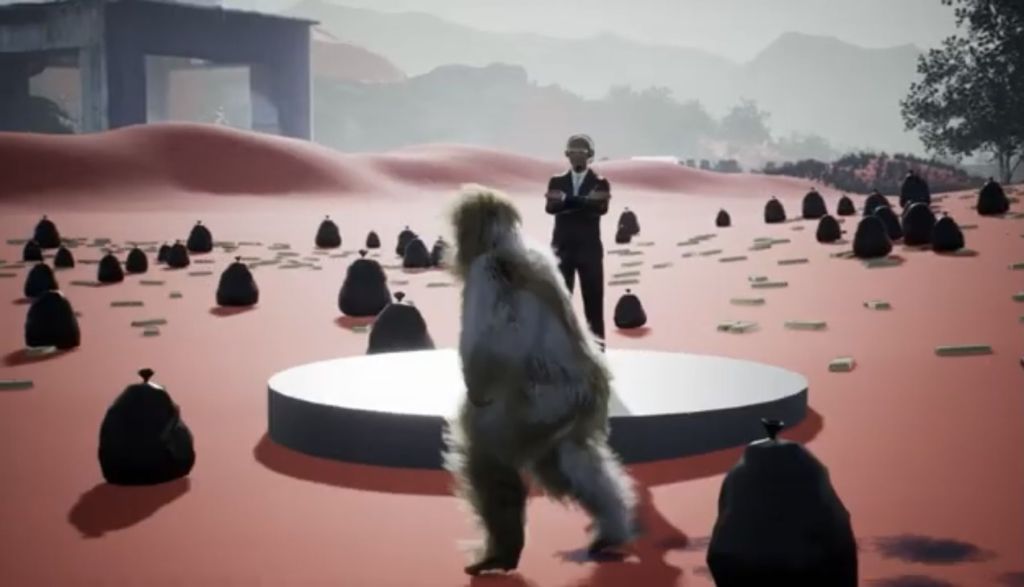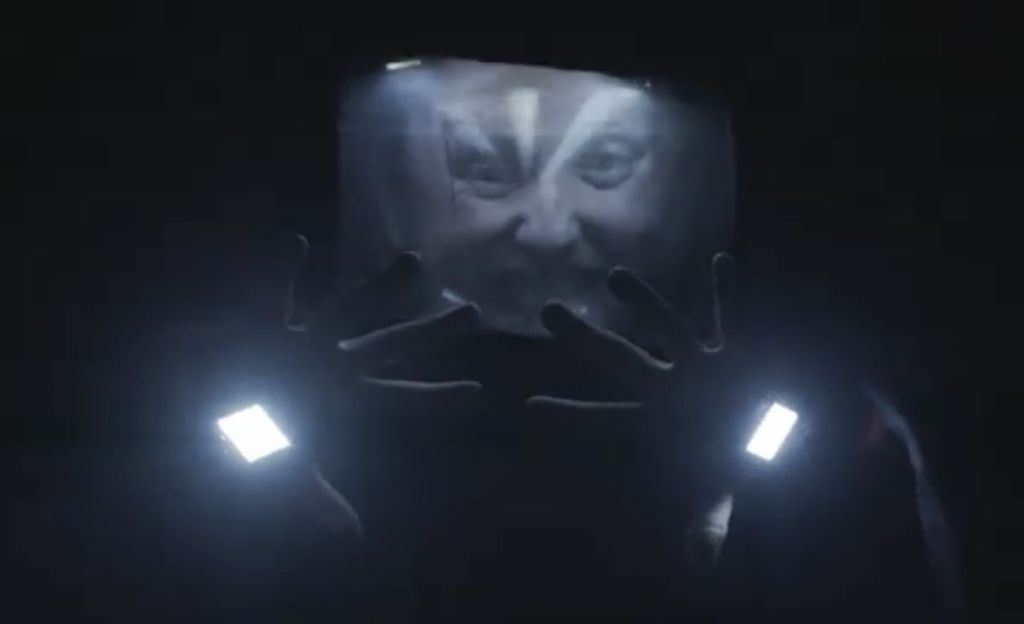Text by Piotr Bockowski

A furry digital creature resembling a crossbreed between Yeti, Bulgarian protective spirits Kukeri or fantasy anime demons and a simulation of a prehistoric man is viewed from the third perspective prevalent in computer games. The furry creature became a virtual agent of the last Ars Electronica participants. They were invited to explore a vast territory of a VR environment projected over a panoramic, concave screen in front of a controller pad.
Conceptualised, programmed, designed and sounded by Patryk Lichota, the Datafixation installation names a portmanteau for database technologies and pathological fixation. The installation effectively becomes a critique of datafication processes, which turn human and nonhuman life into data in an attempt to manipulate life via novel values generated by information tools.
As the furry critter explores a 3D map of a diverse terrain, it passes through a motley patchwork of what looks like corrupt deserts, futuristic urban skylines, rock formations, outerspace abstractions, unspecified vegetation sites, monstrous monuments of a totalitarian regime juxtaposed with an oversized bedroom of e-sports gamer, located alongside metropolitan slums as well as mysterious dumpsites – all of it vividly accentuated against a synthetic red background.
This formal exclamation of Datafixation unnatural landscape frame in the intention of Lichota exposes all elements of his VR environment as modular concepts situated meaningfully in critical relations. With this, Lichota proposes a humanist research method involving VR as a certain mind map, which embodies thoughts in the shapes of digital objects while animating them and enacting their possibilities via Unreal Engine.
As an innovative international media artist and quirky Polish academic, currently residing at a cutting-edge technology institute of NTHU (National Tsing Hua University) in Taiwan, Lichota creates VR art as a media philosophy discourse that “experiences theory”.
The Datafixation video announces that “we live in schizoid data culture”, which allegedly becomes an open cry of collective subconsciousness, fuelled by an overwhelming desire to escape into the imagination of VR. Datafixation was presented within NTHU TechArt Exhibition “Nature of Prototyping”, co-curated by Lichota together with Su-Chu Hsu & Cheng-Yu Pan. The exhibition focused on the technology-related “intensification” of human life, stimulated by our civilisation of overproduction of, not only information but also commodities, images, sounds, other cultural expressions, and people themselves.
In the midst of a complex global crisis, technology is in a double-double bind, according to NTHU: it is the cursed cause of overpopulation as well as the promised solution (sic). It is also a condition for the chaos of globalisation, but at the same time, it becomes its ever-updating effect.
NTHU was established as the major techno-research institution of the greatest world population in Beijing in 1911, in the very first year of Republican China was freed from British colonialism and its late puppet Chinese Empire. It became re-established in 1956 at its present location in Hsinchu, Taiwan, where China government escaped their defeat by the Chinese Communist Party.
Hence, choosing his collaboration with NTHU, Lichota interrogates the acute tensions of globalised post-industrial society firsthand.
Datafixation seems to be a form of post-sacral, primitive superstition experienced by a digital furry corrupted by data architecture that permeates the Earth. In its erratic chase through the VR mind-space of Lichota, the furry is animated by a control pad, which mobilises video game and ship cockpit conventions as “a fantasy of human cosmic escape from Home”.
The furry encounters an astronaut hanging in the air over a concrete shelter amongst sandy dunes, accompanied by found footage of luxury tourist trips into outerspace. This cosmic vector of technological imagination unavoidably suggests a new level of religious experience afforded by tools of capitalist control and violence.

The corporate capital is represented by various absurd characters and scenes, amongst which a group of silver ‘digital cowboys’ exhibit their armour cladding of computer design. Moreover, the furry witnesses a skinned and meaty anatomical model dancing in a derelict slum alleyway, what potentially illustrates the perverted ecstatic joy of our civilisation of waste or “energetic implosions and black holes absorbing the planet’s material resources,” as described by Lichota. In the open of a computer-generated wasteland, a corporate suit man exercises his PR amongst black trash bags – what in the narrative of Datafixation alludes to the enormous energy waste and carbon footprint as an effect of the industrial production of digital currencies.
Typhoon whirlpool twists around cash machines and focuses the tropical cyclone eye on environmental issues stirred by digital money laundering. With these and other VR scenes, datafixation uncovers an uncomfortable materiality underlying corporate propaganda of the ‘digital media society’, spanning from cryptocurrency mines through social networking to NTS auction houses. At last, in the moment of acute self-reflection of Ars Electronica, digital art becomes a self-aware form of coding techno-capital, which performs dataviliance, life mining and countless strategies for the commodification of creatures.






